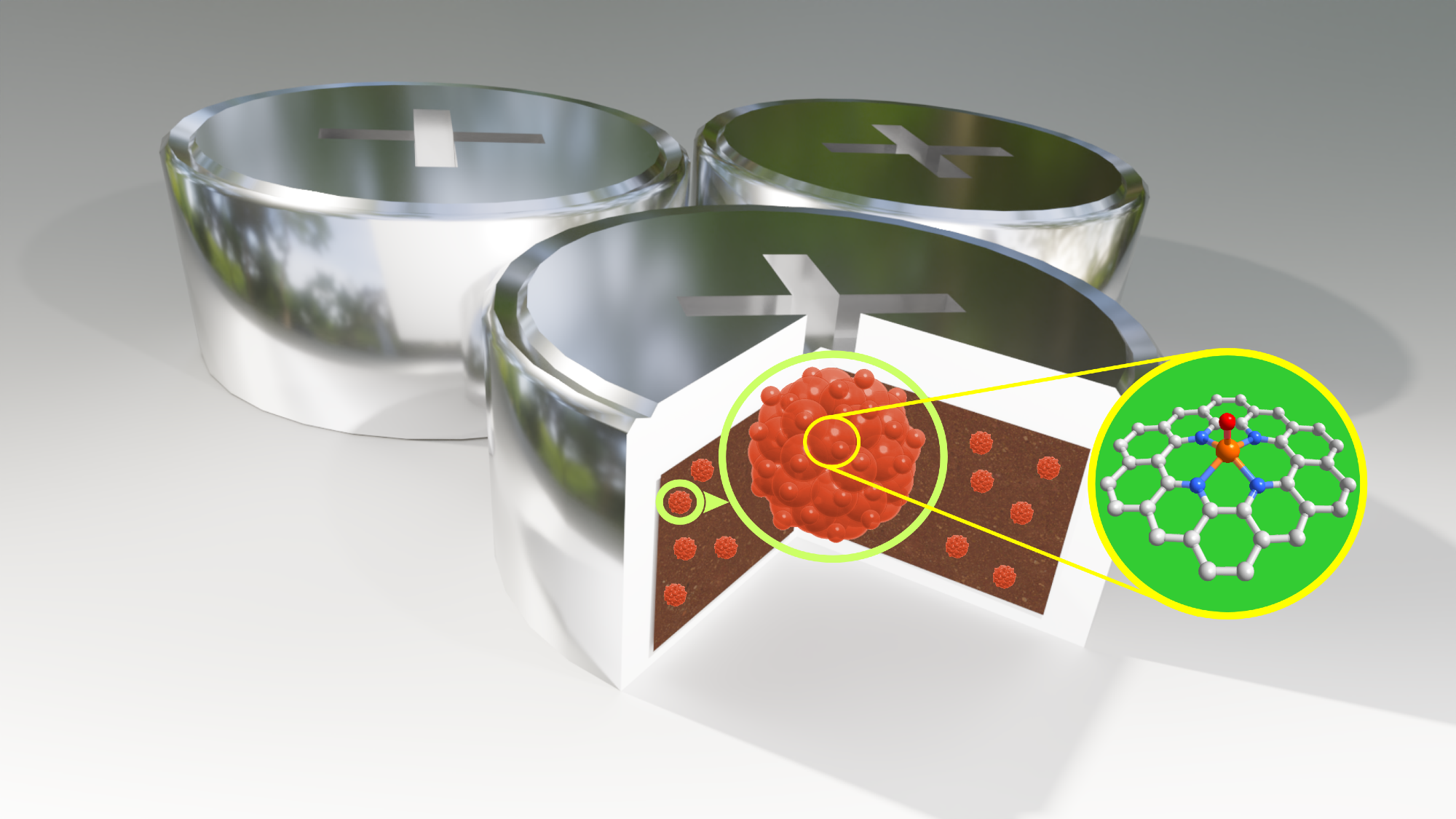Without contemporary energy storage technologies, the long-term shift towards renewable energies is impractical. These include batteries, which are devices that temporarily store electricity as chemical energy. The presence of appropriate catalysts, which enable the associated chemical reactions to proceed optimally, is crucial for their efficiency.
 Going into detail: The porous catalyst (red balls) accommodates dense catalytically active zirconium sites (exemplified in the yellow circle) on its surface, thus improving the battery’s chemical reactions associated to energy storage. Image Credit: HZDR/Bernd Schröder, Minghao Yu
Going into detail: The porous catalyst (red balls) accommodates dense catalytically active zirconium sites (exemplified in the yellow circle) on its surface, thus improving the battery’s chemical reactions associated to energy storage. Image Credit: HZDR/Bernd Schröder, Minghao Yu
The zinc-air battery, a well-known type of battery that is now primarily used as button cells, for example, in hearing aids, has recently drawn the attention of scientists in Dresden. They created a brand-new catalyst using zirconium as a base metal to achieve this.
It can take the place of platinum, the precious metal that has been used as a catalyst the most frequently up to this point, and still turn the battery into a powerhouse.
The new catalyst significantly enhances the performance of charging and discharging the battery. It is also very resilient; the test battery still held 92% of its initial current after 130 hours of use.
This is an excellent value considering that we are still in the early development stages.
Dr Agnieszka Kuc, Institute of Resource Ecology, Helmholtz-Zentrum Dresden-Rossendorf
She investigates the chemistry and physics of battery catalysts. Their metal atoms serve as catalytically active sites and are frequently used as metal nanostructures on suitable support materials.
The performance of such catalysts depends on the size of the metal particles used. Research has shown that the smaller the metal particles that house the metal atoms are, the more effective they are as catalysts.
The ultimate frontier is the single-atom catalyst: isolated metal atoms individually distributed on a support. In our case, however, we have also an oxygen atom as an additional coordination partner above our metal, which leads to further interaction with the electronic structure of the zirconium.
Dr Minghao Yu, Research Group Leader, Dresden University of Technology
He creates catalysts based on a single transition metal atom, such as zirconium, trapped in a matrix of carbon by nearby carbon or nitrogen atoms that are lying in a plane.
The so-called overpotential, a measurement of the deviation of the actual chemistry in the battery cell from what could be expected theoretically, is a phenomenon that limits the practical efficiency of many electrochemical reactions. The catalyst is intended to lessen its effects.
Dr Kuc added, “This basically means that we can harness less energy than thermodynamics predicts.”
Tricky Miniaturization
The key to effectively converting chemical energy into electrical energy is the reduction of this overpotential, achieved by catalysts. For commercial applications, platinum-based catalysts are currently the gold standard in battery chemistry.
They do have a drawback, though, in that platinum is extremely expensive and is only occasionally found in the earth’s crust. Therefore, research in recent years has concentrated on creating novel catalysts based on less noble metals as viable alternatives.
The base metal zirconium is the candidate that Dresden scientists are now supporting as it truly breaks records.
A consequence of miniaturization that the TU Dresden, Max Planck Institute for Chemical Physics of Solids (MPI-CPfS), and HZDR researchers had to monitor was: The agglomeration of those same particles into small clusters is encouraged by decreasing particle size.
Limited performance follows, especially at high operating current densities. This agglomeration is avoided by using a suitable carrier material that interacts strongly with the metal, resulting in stable, finely distributed metal clusters with high catalytic activity.
The catalysts can achieve high activity and selectivity with a clearly defined and uniform distribution of metal atoms.
“In our case, we isolated our synthesized material on the surface of quartz spheres, which have a porous structure advantageous for catalytic processes. In our arrangement, we found a pronounced aversion of zirconium to agglomeration, so we were able to produce catalysts with a high zirconium load. As a result, we have achieved a record-breaking power density among all zinc-air batteries previously made with single-atom catalysts,” further stated Dr Kuc.
Journal Reference
Wang, X., et al. (2022) Atomically Dispersed Pentacoordinated-Zirconium Catalyst with Axial Oxygen Ligand for Oxygen Reduction Reaction. Angewandte Chemie, International Edition. doi:10.1002/anie.202209746.